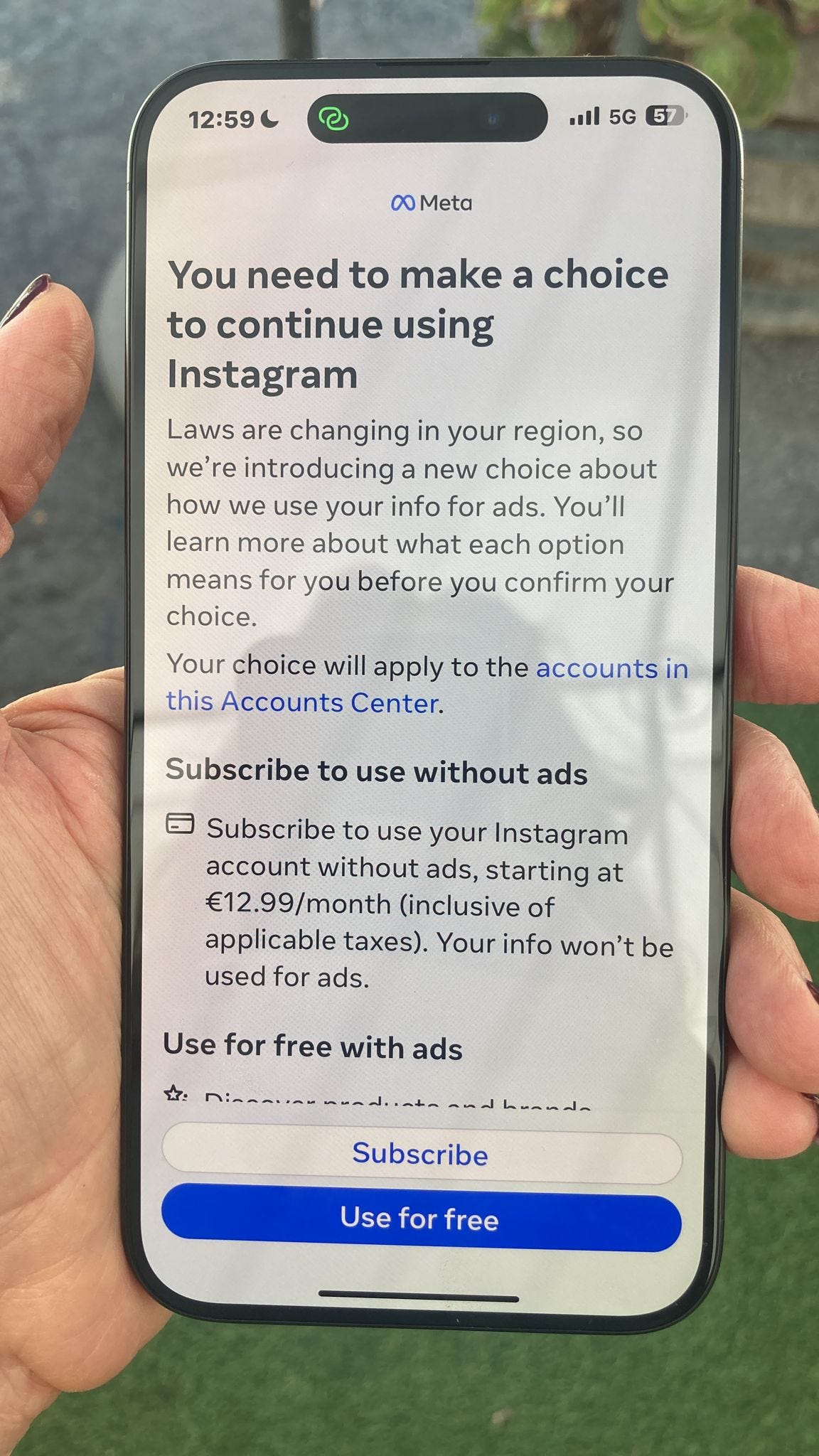EU Instagram Users Can Now Pay To Avoid Ad Tracking
Regulations challenge Meta's vision of ad-supported Internet
Instagram and Facebook users in the European Union can now pay a subscription fee to avoid on-platform advertising and personal data collection.
Meta, Facebook and Instagram’s parent company, was reported to be considering the subscription plan in September, and announced that it was moving forward with it on October 30, 2023.
I missed that announcement, however, until a friend who lives in the EU messaged me asking what was going on with her Instagram account. On Tuesday, when she tried to access her Instagram app, she saw a screen prompting her to “make a choice to continue using Instagram.”
The screen requires her to make a selection of “Subscribe” or “Use for free” before being able to access her Instagram account. The paid version of Instagram is starting at €12.99 if purchased through the app and €9 if purchased through the website,1 and by March 2024 Meta will charge an additional €8 (mobile) or €6 (web) for each linked account.
When a user selects “Use for free”, the text makes it clear that the “free with ads” option is the pre-existing Instagram experience we all know and hate, but is requiring an active opt-in to data tracking that I imagine many Instagram users haven’t seen in years.2
But why is this happening now?
The EU Tries To Hold Meta Accountable
This past summer, Meta lost an appeal to overturn an antitrust case brought by Germany that centered on Meta’s advertising platforms. One of the key government complaints was that Meta bundles personal data across it’s products without getting customer consent. The ruling applied only to Germany, but is being used as a case study for the new EU Digital Markets Act.
This subscription model is a way to engineer consent for data harvesting in order to comply with the ruling. In their subscription offer announcement, Meta writes:
The option for people to purchase a subscription for no ads balances the requirements of European regulators while giving users choice and allowing Meta to continue serving all people in the EU, EEA and Switzerland. In its ruling, the CJEU expressly recognised that a subscription model, like the one we are announcing, is a valid form of consent for an ads funded service.
It’s exciting to see what’s possible when a government actually protects its people from the excesses of multinational corporations like Meta. The Digital Markets Act has punitive fines of up to 20% of global turnover for repeated violations, which is enough to make Meta come to heel. This ruling the clearest marker of the diverging big tech experience between the EU and the US, as US users remain unable to opt-out of advertising, and absent legal changes in the US, there’s no reason for Meta to implement a subscription option.
Meta Commits To The Ad-Supported Internet
Because let’s not get confused: Meta has no desire to get conscious consent for personal data harvesting, and certainly does not want your €12 per month more than it wants to show you ads. We can see this in the UX of the Instagram opt-in page: the highlighted button is “Use for free.” Meta hopes that users click that button without even thinking about it, and that €12 is high enough to act as a deterrent to paid subscriptions.
I suspect that’s right. I doubt we’ll see the numbers, but I’m willing to bet that the vast majority of EU users will continue to use Instagram and Facebook for free. Users won’t select free because they want to hand over their data and see ads, but because €12 per month is a lot for a platform that they are used to using for free, and for a platform that continues to be overrun with bots, suppresses information,3 and generally seems to make a lot of people miserable.
Meta remains committed to its business model, writing:
We believe in an ad-supported internet, which gives people access to personalised products and services regardless of their economic status. It also allows small businesses to reach potential customers, grow their business and create new markets, driving growth in the European economy.
Meta may try to present itself as standing up for the people who can’t afford a subscription, but they have a made an explicit choice about the price, effectively preventing equal access to the platform.
What do you think? Is the subscription model a good thing, and something you hope to see continue? Is this all smoke and mirrors, and does it let Meta off the hook? I’m leaving comments open; I want to hear from you.
The higher mobile rate is to account for Apple and Google App Store fees
I’ve been on Instagram since 2013 and have no memory of what terms I agreed to when I joined. The terms are accessible through Meta’s website of course, but the forcing function to require EU users to opt-in again is interesting and actually made my friend pause when she realized what she was agreeing to.
It’s worth noting that Threads is actually not available in the EU still due to these regulations, but Covid health information is actively suppressed in search on Threads in one of the most explicit examples of platform censorship that we’ve seen from Meta. Much of Meta’s censorship has been through shadow bans and algorithmic trickery. This one is very clear.






